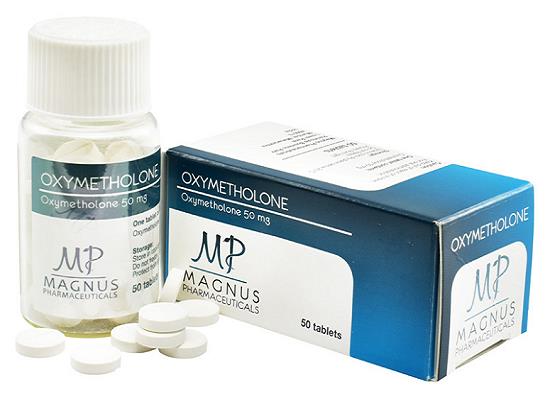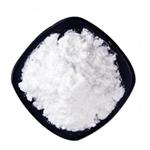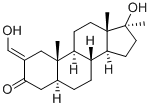Oxymetholone: pharmacokinetics and clinical applications
Sep 26,2023
General Description
Oxymetholone is a 17α-alkylated anabolic-androgenic steroid and a synthetic deriva- tive of testosterone. It is well absorbed after oral administration and undergoes metabolism in the body. The drug has minimal interactions with cytochrome P450 enzymes. Oxymetholone has shown superior anabolic activity compared to methyltestosterone and can increase erythropoietin levels. In terms of clinical applications, it has shown promise in treating acquired and congenital anemia, including hypoproliferative or aregenerative anemia and myelofibrosis. It has also been used to treat HIV-related wasting, leading to weight gain and improved nutrition scores. Additionally, oxymetholone has been studied for its potential in treating impaired growth in children, showing an increase in height and body weight.

Figure 1. Tablets of oxymetholone
Pharmacokinetics
Limited information is available on the pharmacokinetic profile of oxymetholone. It is believed to be well absorbed after oral administration, similar to testosterone. Once in the bloodstream, oxymetholone undergoes phase I and phase II metabolism. While it has the potential to interact with cytochrome P450 enzymes, such as CYP2D6, CYP3A, CYPlA2, or CYP2C19, the clinical significance of these interactions seems to be minimal. Further studies are needed to fully understand any potential drug interactions. The primary metabolic reactions of oxymetholone involve oxidation, reduction, and hydroxylation. A small percentage of the drug is excreted in urine as conjugates of glucuronic acid. Several metabolites have been identified, but their effects and relationship to hepatotoxicity in humans are still uncertain. Oxymetholone has shown superior anabolic activity compared to methyltestosterone based on nitrogen retention and can increase urinary erythropoietin levels up to 5-fold. However, due to interpatient and intrapatient variability, it is challenging to establish a dose-response relationship. 1
Clinical applications
Acquired and congenital anemia
Oxymetholone is a medication that has been extensively studied for its effectiveness in treating acquired and congenital anemia. It has shown promising results in various patient groups and has demonstrated positive effects on anemia remission. In patients with hypoproliferative or aregenerative anemia, particularly those with hypocellular marrow, oxymetholone treatment has resulted in partial or full remissions. Patients with myelofibrosis and thrombocytopenia have also experienced improvement after oxymetholone therapy. Studies have shown that oxymetholone can lead to an increase in hemoglobin levels, reticulocyte counts, and improvements in neutrophil and platelet numbers. Increases in bone marrow cellularity have been observed during remission, and some patients have achieved permanent remissions that last up to 5 years after treatment cessation. Furthermore, oxymetholone has shown efficacy in treating acquired aplastic anemia. In some cases, the dose of oxymetholone was directly related to blood cell counts, resulting in significant benefits for patients. In conclusion, Oxymetholone has shown promise in the treatment of acquired and congenital anemia, particularly in specific patient groups. 2
HIV-related wasting
Oxymetholone has shown potential in treating HIV-related wasting in patients with advanced HIV infection. In a study, patients were given oxymetholone alone or in combination with ketotifen, an anti-tumor necrosis factor-alpha activity medicine. Both treatment groups showed significant improvement in their mean body weight, with a gain of 8.2 kg (14.5%) in the oxymetholone group and 6.1 kg (10.9%) in the combination therapy group. Additionally, appetite/nutrition scores improved by 91% in both groups. The mean Karnofsky score, which measures the ability to perform daily activities, also improved in both groups. In another pilot study, oxymetholone was given to HIV-positive men, and their mean body weight increased slightly from 100% to 104% of ideal body weight. No significant adverse effects were observed, and patients reported less anorexia, depression, and fatigue after treatment. Although oxymetholone has been associated with some hepatotoxicity in patients with advanced HIV disease, it was generally well-tolerated, and serum albumin concentrations increased in 20% of patients. 3
Impaired growth in children
Oxymetholone has been studied for its potential application in treating impaired growth in children. In a double-blind, placebo-controlled study, it was found that after 12 months of treatment, the group of children receiving oxymetholone showed a statistically significant increase in mean height compared to the placebo group. Additionally, there was a significant difference in body weight gain between the oxymetholone group and the placebo group. Another study investigated the effect of oxymetholone on bone growth in nonambulatory osteoporotic children. Patients were either given combination therapy with oxymetholone and fluoride or oxymetholone monotherapy. After 18 months, the combination therapy group showed a mean rate of bone growth of 8.7%, while the monotherapy group showed a 7.0% increase. Although not statistically significant, the combination therapy group exhibited a higher growth rate during the follow-up phase. These findings suggest that low doses of oxymetholone can lead to a slight but significant increase in growth in undersized children without significantly affecting skeletal age. Additionally, intermittent oxymetholone and fluoride therapy may contribute to rapid bone mineralization in nonambulatory osteoporotic children. 4
Reference
1. Thacker DL, Wainer I, Lerch C, et al. Metabolism of an anabolic androgenic steroid, oxymetholone, by human cytochrome P45Os. Clin Pharmacol Ther. 1999, 65:75.
2. Pavlatos AM, Fultz O, Monberg MJ, Vootkur A, Pharmd. Review of oxymetholone: a 17alpha-alkylated anabolic-androgenic steroid. Clin Ther. 2001, 23(6):789-801.
3. Hengge UR, Baumann M, Maleba R, et al Oxymetbolone promotes weight gain in patients with advanced human immunodeficiency virus (HIV-l) infection. Br J Nut. 1996, 75:129-138.
4. Keele DK, Worley JW. Study of an ana- bolic steroid. Certain effects of oxymetholone on small children. Am J Dis Child. 1967, 113:422-430.
- Related articles
- Related Qustion
- Oxymetholone: Mechanism of Action, Side Effects and Dosage Mar 22, 2024
Oxymetholone treats anemias but poses hepatotoxicity risks. Its mechanism targets muscle wasting via androgen receptors, requiring careful monitoring.
- Oxymetholone - Medical uses, Mechanism of Toxicity and Environmental Fate Oct 29, 2021
Oxymetholone, marketed as Anadrol, is a synthetic anabolic steroid developed in 1960s. Its primary clinical applications include treatment of osteoporosis and anemia, as well as stimulating muscle growth.
Avatrombopag is a medication that treats thrombocytopenia by mimicking thrombopoietin, increasing platelet count through receptor activation and signal pathways.....
Sep 26,2023APICalcitonin is a human hormone. Salmon calcitonin and human calcitonin inhibit the function of osteoclasts, which are active in the pagetic process.....
Sep 26,2023Biochemical EngineeringOxymetholone
434-07-1You may like
- Oxymetholone / Anadrol
-

- $45.00 / 1Box
- 2024-04-29
- CAS:434-07-1
- Min. Order: 1Box
- Purity: 99.99%
- Supply Ability: 10000000000
- Oxymetholone
-

- $1100.00 / 1kg
- 2024-04-29
- CAS:434-07-1
- Min. Order: 1kg
- Purity: 98%
- Supply Ability: 1000kg
- Oxymetholone; Anadrol
-

- $60.00 / 1kg
- 2024-04-29
- CAS:434-07-1
- Min. Order: 1kg
- Purity: 99.99%
- Supply Ability: 500kg





